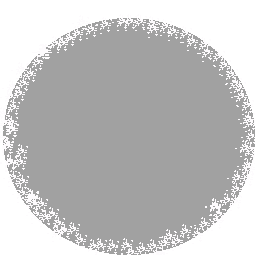So here it is.
I’m going to assume we start with a homogeneous mass
containing all the things that will be solid grains out at a temperature of
very few K and that have been shown to be in comets. So sodium and magnesium
silicates, and ammonia, and methanol, and carbon dioxide, and carbon monoxide,
and water, and methane – and importantly some higher hydrocarbons, which
haven’t showed up in the gas from 67P-Churyumov-Gerasimenko but seem to be
attested in other systems. I guess the primordial assumption behind this is
that comets formed from the outer edges of the big solar system Ur-cloud, so
weren’t subjected to much in the way of fractionation processes beforehand. If
this is some terrible error in cometology, please let me know.
We roll all these things into a ball using gravityTM
and hurl it towards the sun.
Some of this fluffy stuff will flake off and float away; probably a lot;
but it will also invariably compact as bits flake off and lodge with other
bits, and at temperatures where higher organics are not volatile but the small
molar mass stuff is, these latter will end up concentrated on the surface where they can
soak up all those lovely cosmic rays and start forming larger crosslinked
molecules by radical-radical recombination.
Okay, if the mass of the comet is small this evaporation process will
just continue until you are left with a relatively dense mass of non-volatiles. But if the
mass is bigger, this surface layer – which is gradually getting more compact
and more enriched in high molar mass organics as we approach the sun – will
start acting as a barrier to the progress of gas molecules from the warming
interior.
And eventually, I can imagine this means there won’t be
vacuum at the interior surfaces where sublimation is occurring, but appreciable
pressure. There seem to be abundant studies in the literature for gas building
up in comets.
Now, once the pressure and temperature increase above the triple
point of any of the constituents of the comet interior, there will be the
possibility for liquid to exist there.
I’ve plotted the triple points of some constituents of
comets below.
(Note, if you are unfamiliar with triple points, that these
are the bottom points of triangular areas where the liquid state can exist. The
exact phase diagrams of things are much more difficult to find than the triple
points and may not have been mapped out in detail for all of these.)
The species that are going to be liquid at relatively low
temperatures and pressures are relatively minor constituents of comets, of the
order of a few percent in total (probably), so we won’t get a gooey liquid
core, but a ‘moist’ core with liquid on the surfaces of solid grains, like a
fairly dry soil. This will happen at temperatures and pressures far below what
we would need to liquefy water, and these liquids will persist in the core
as more volatile components turn into gas and bubble out, while the shape of
the comet is maintained by the outer layer of non-volatiles gummed together by
organic polymer.
Now, when the comet flies out into the cold again, the
interior part of this liquid core is likely to freeze before it evaporates, leaving the core of the comet
no longer a loose aggregation of stuff, but particles of relatively
non-volatile components sintered together with a layer of frozen hydrocarbons.
This will still have a low tensile strength, but I would think this sintering
would significantly improve its compressive strength. And the different levels of degassing possible from a fairly rigid external shell would fit the great variability in comet densities observed. There may also be
interesting fractionation of one component freezing before another, depending
on how good the outer layer is at retarding heat and mass transfer from the
interior. How hot can it get inside? How high can the pressure get? I guess I should look up people's best guesses for those questions. I can imagine the shell getting stronger and stronger on repeated passes of the sun if it doesn't break, sustaining higher pressures inside, and eventually allowing the same sintered morphology to be reproduced with water ice holding inorganic particles together.








2 comments:
This is perfectly logical, and matches these repeatable observations.
1) formation of exocomets in molecular clouds near other stellar systems in the galactic neighbourhood.
2)dark exterior of comets
Cometologists insist that we should assume comets are pristine and unchanged from their accretion from the molecular cloud.
Hmm, and yet there are asteroids that are provisionally idenitifed as comets that have run out of volatiles... http://en.wikipedia.org/wiki/3552_Don_Quixote
Post a Comment